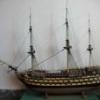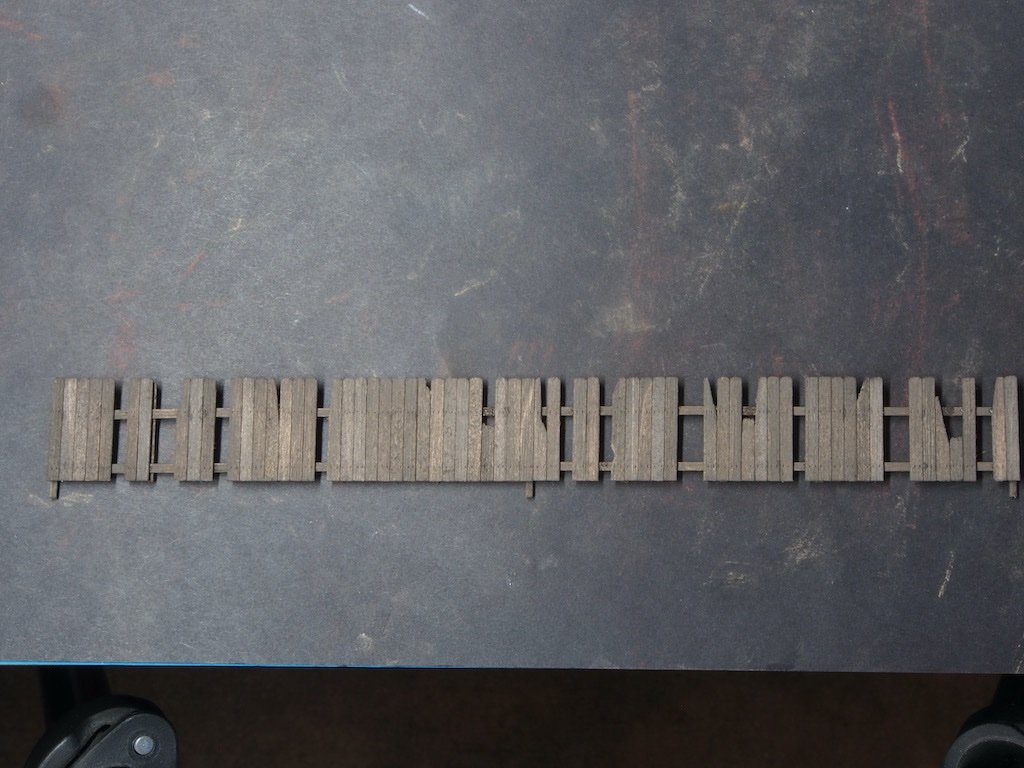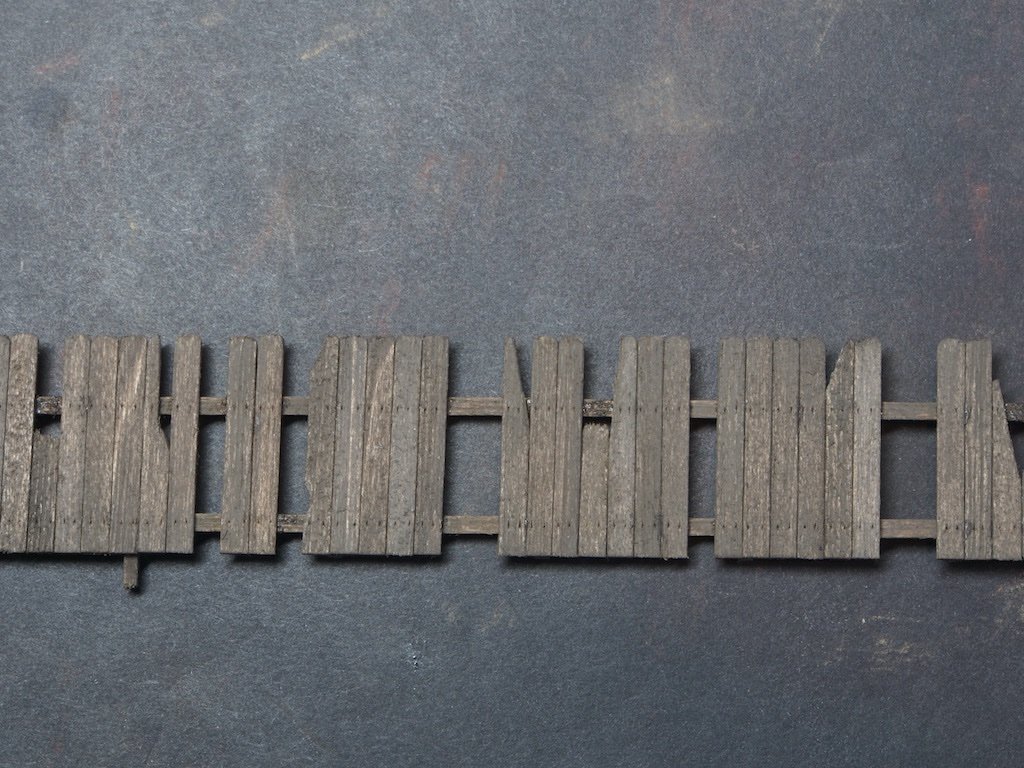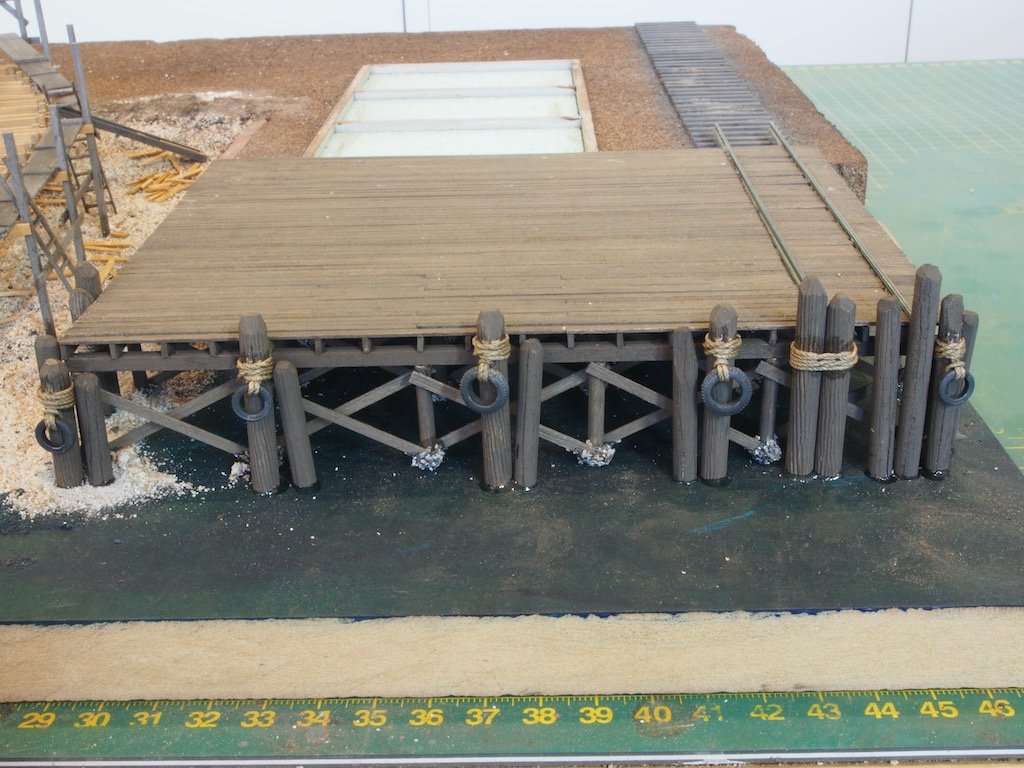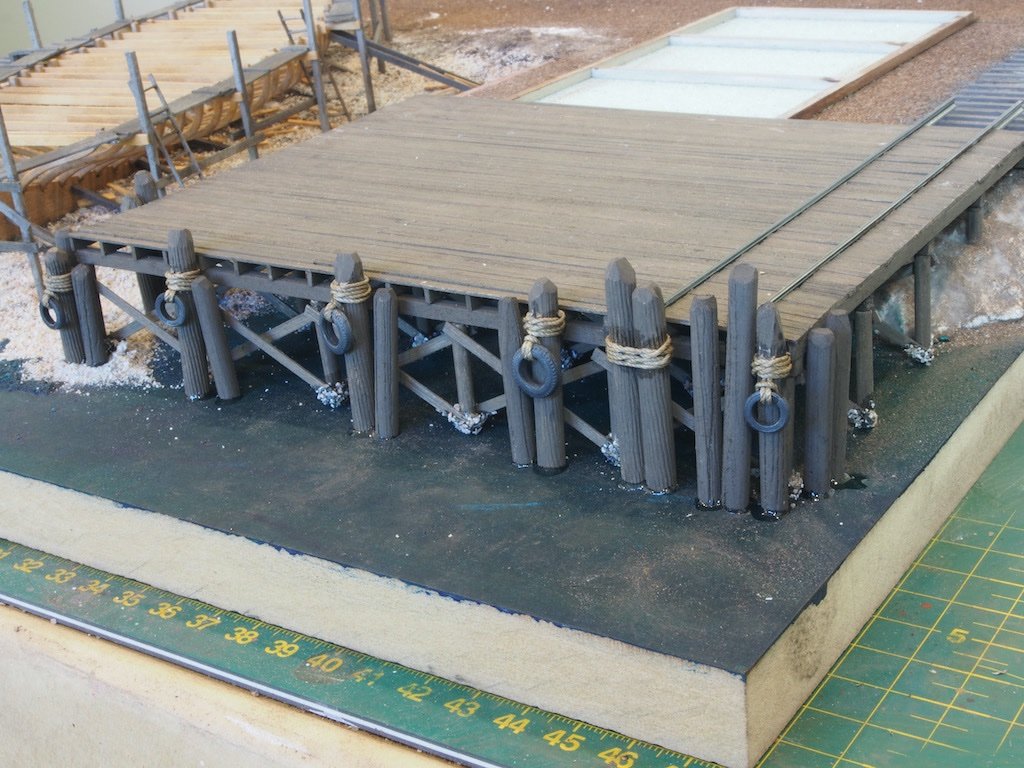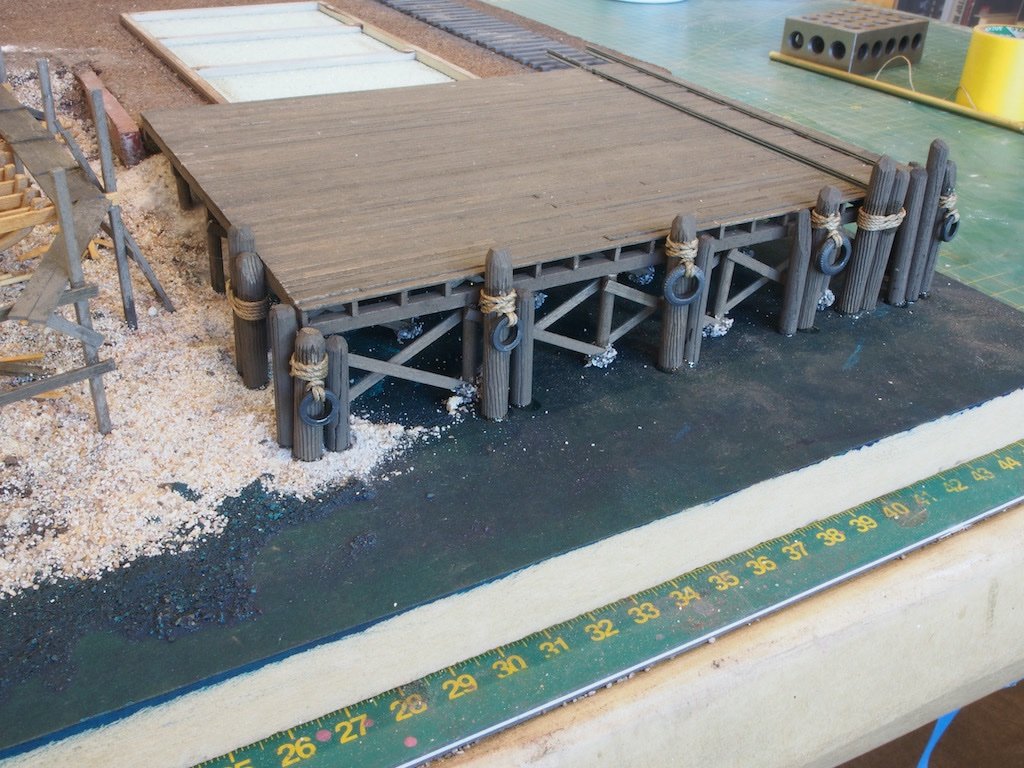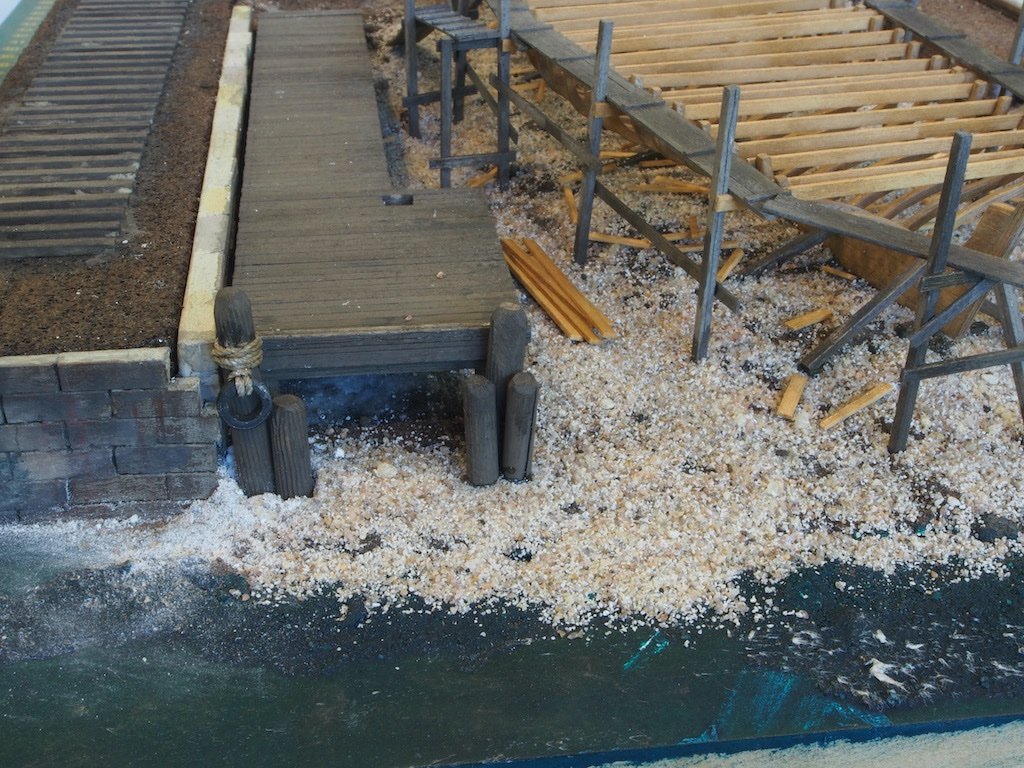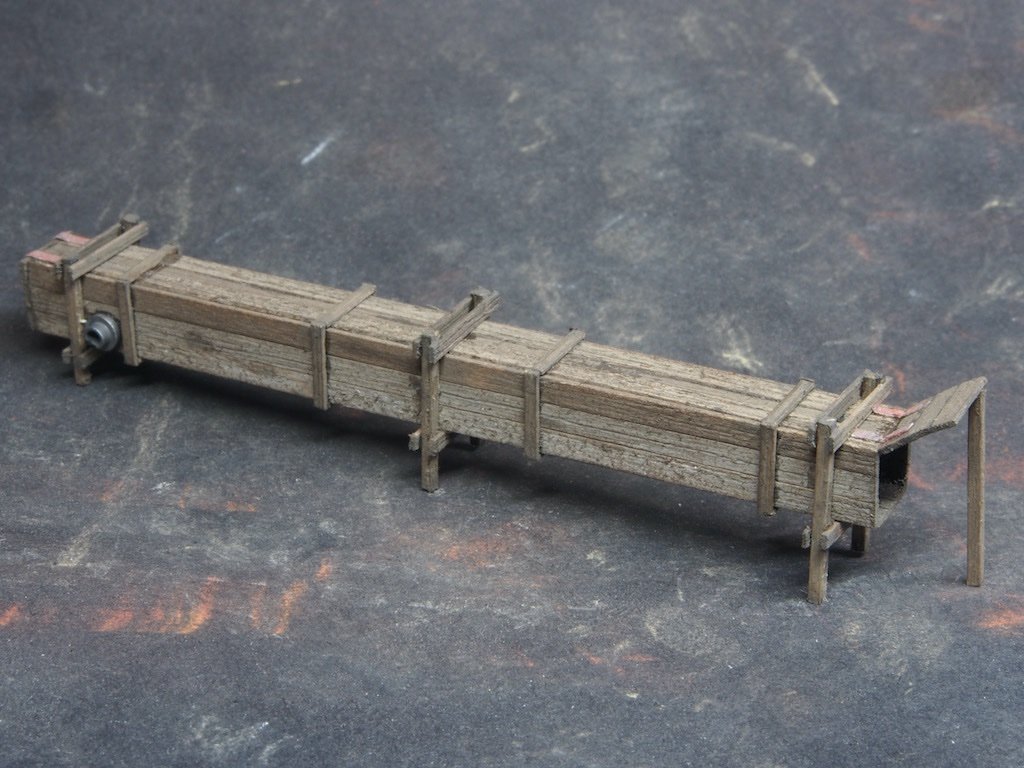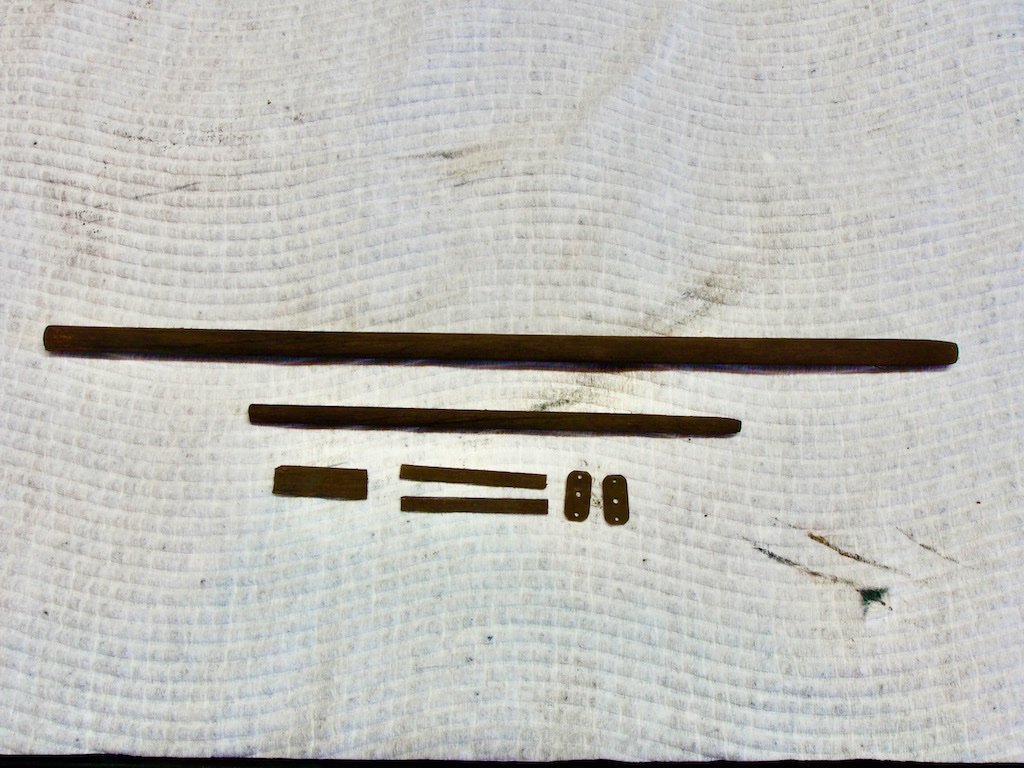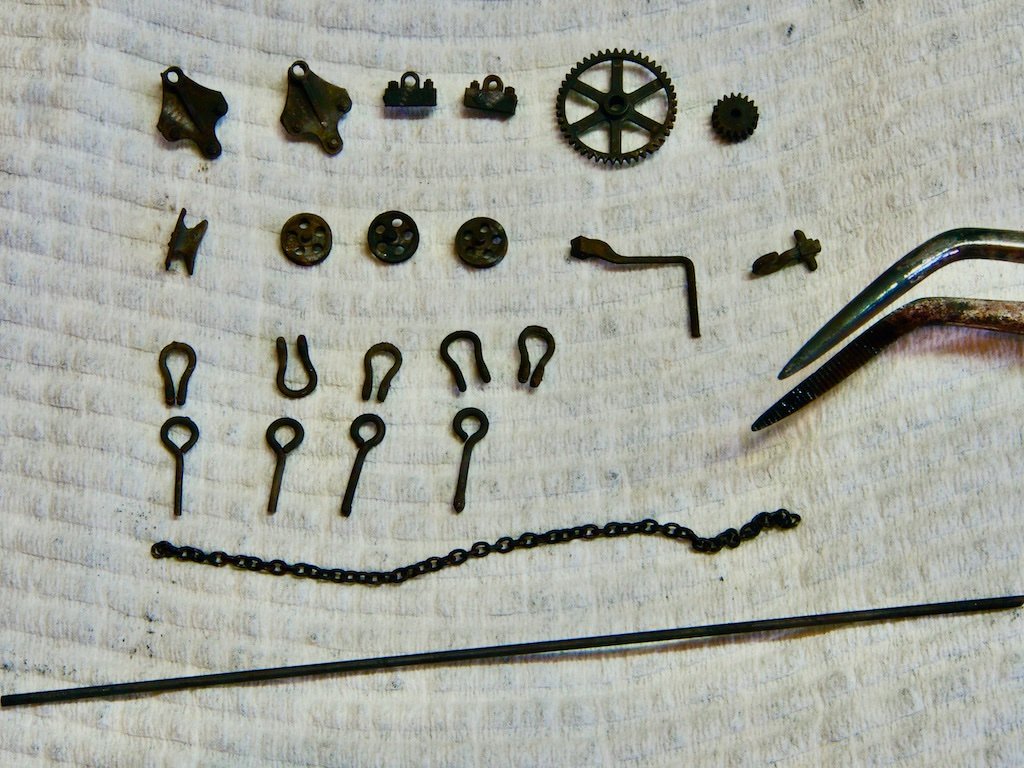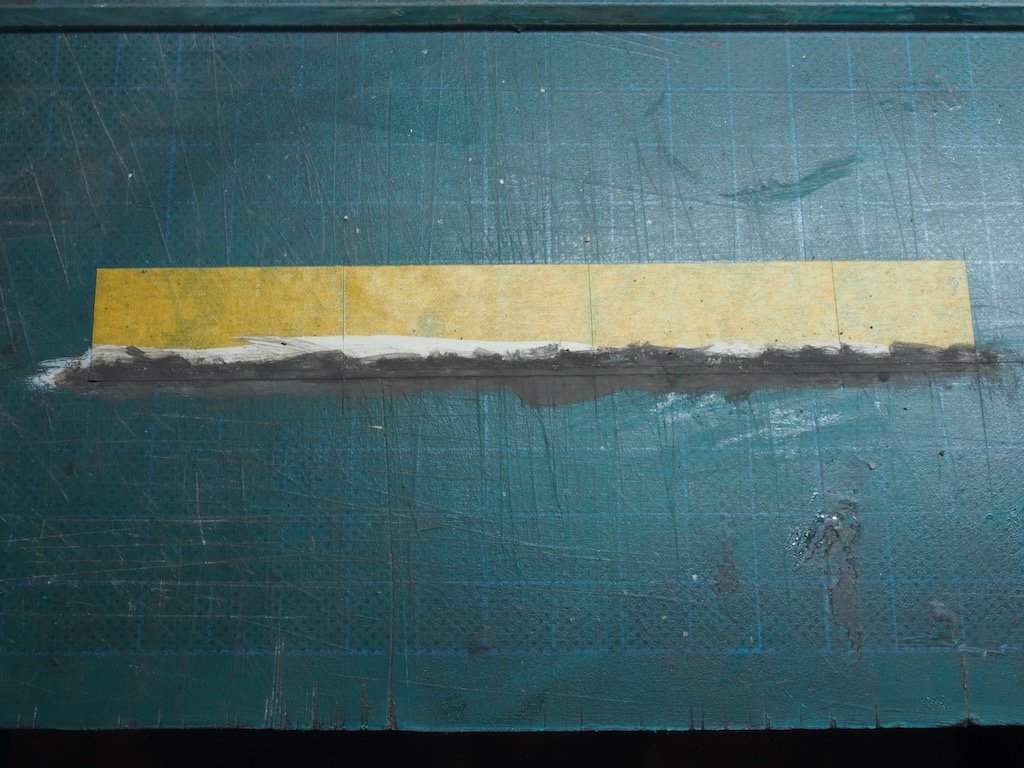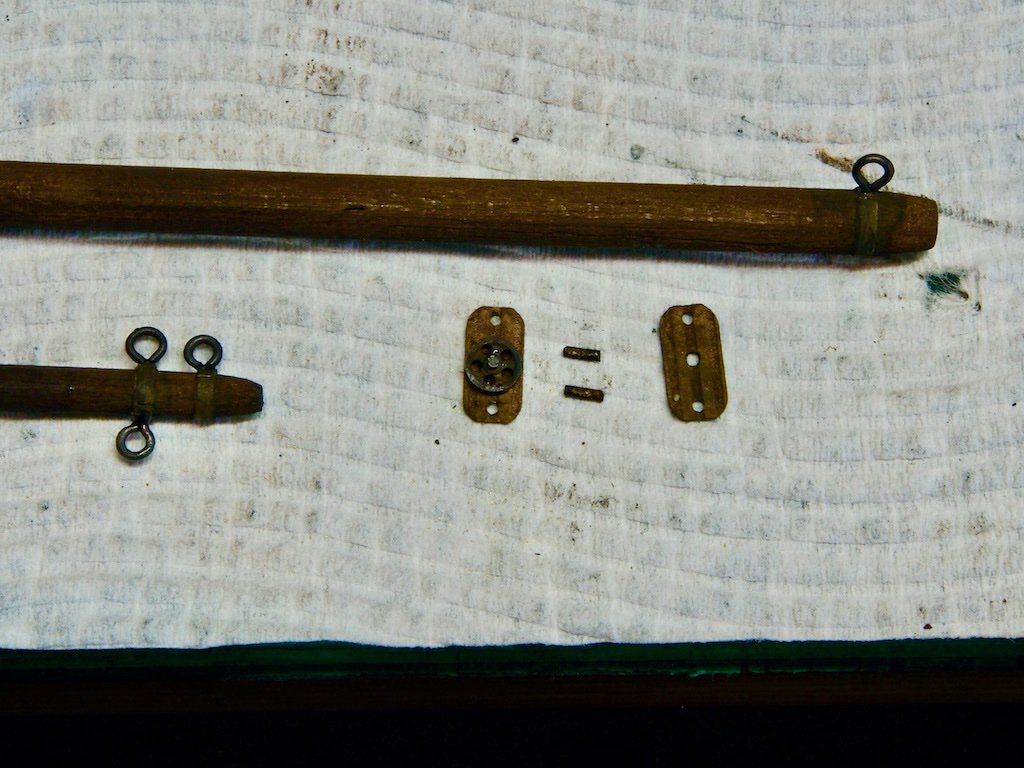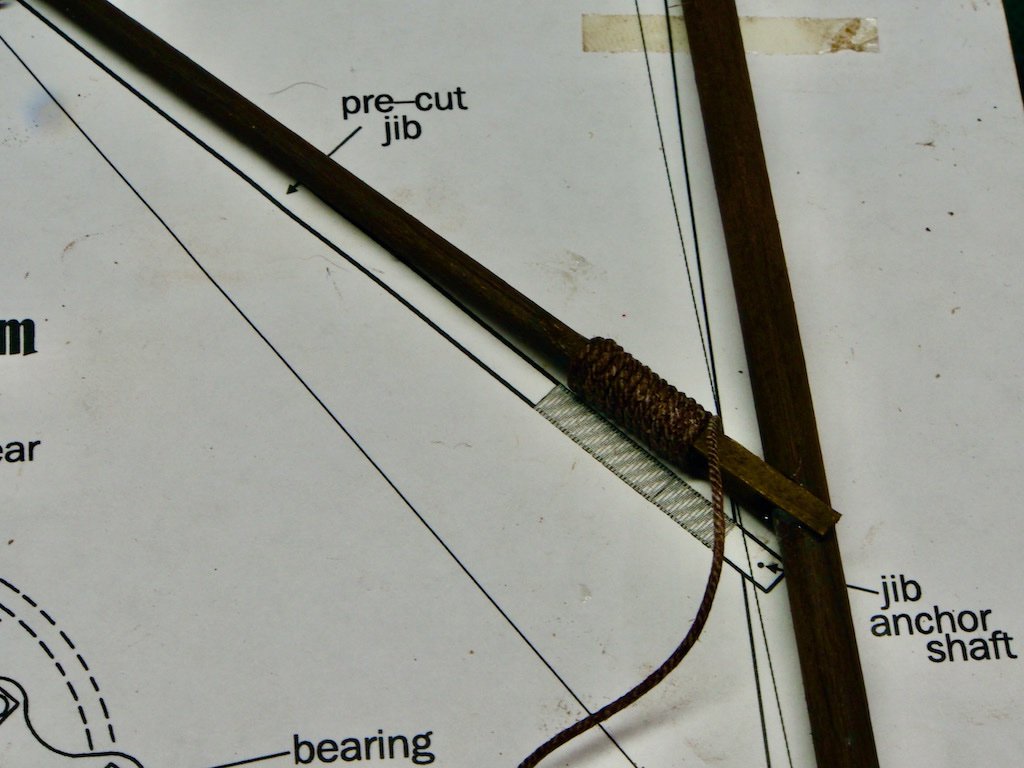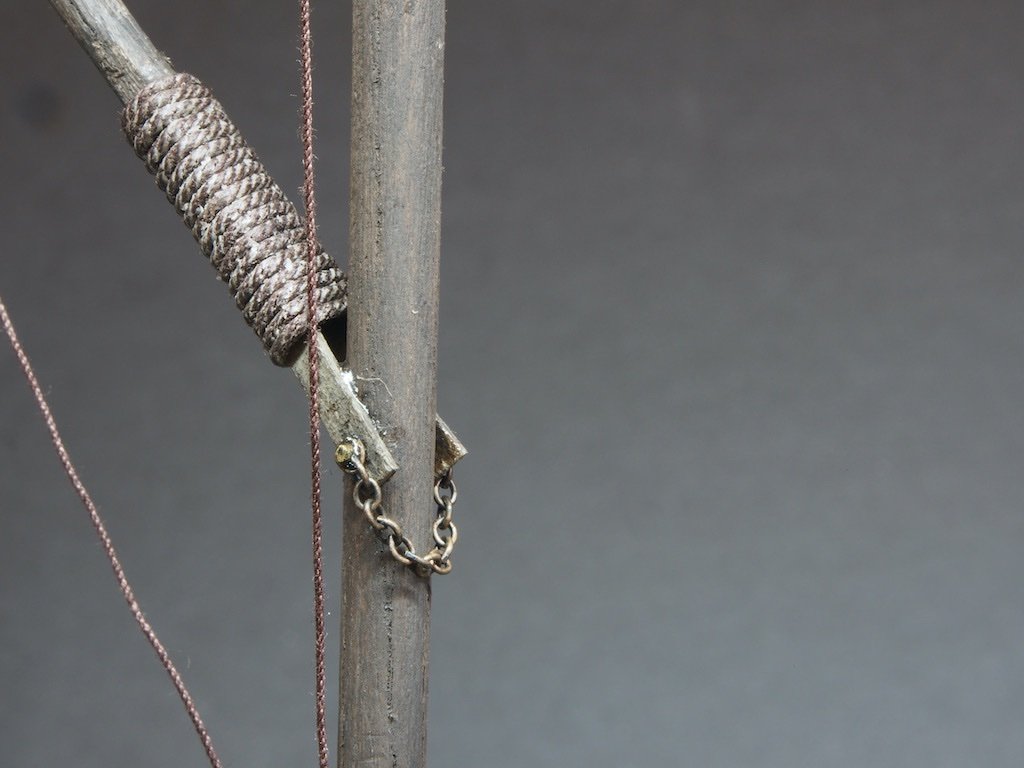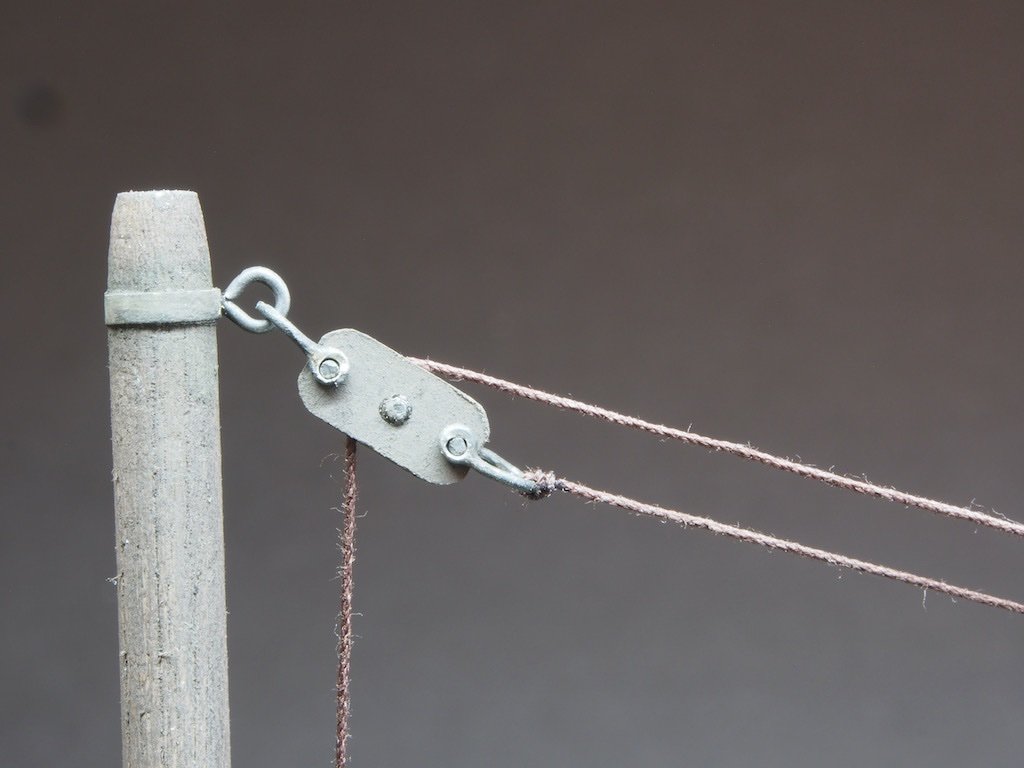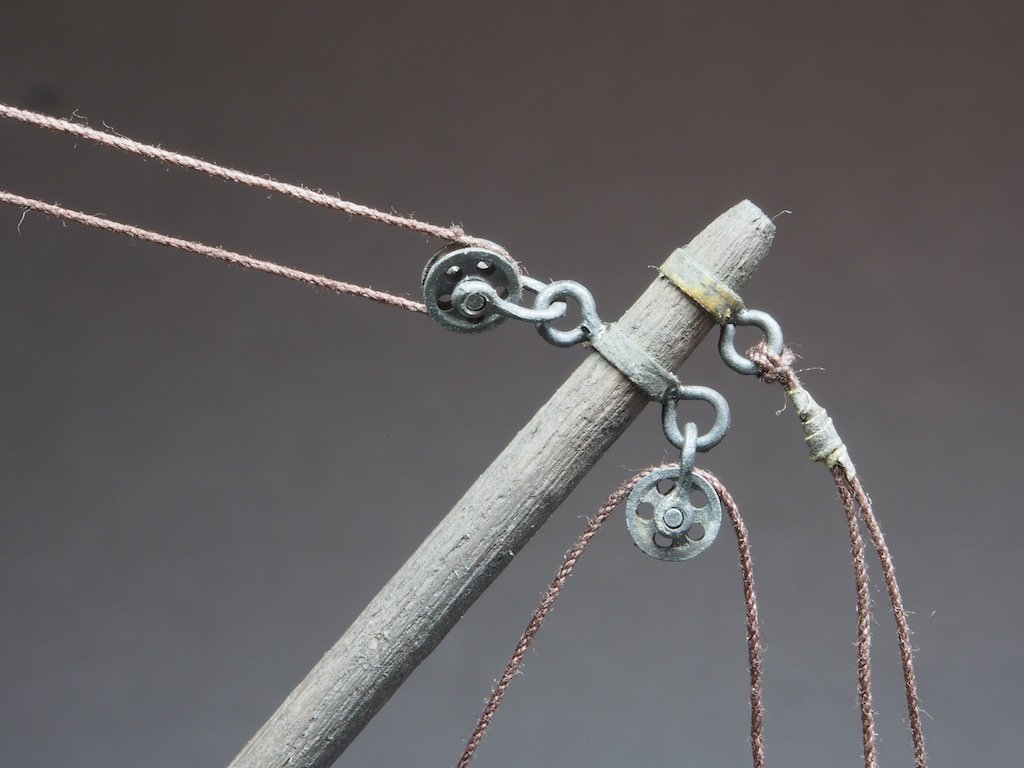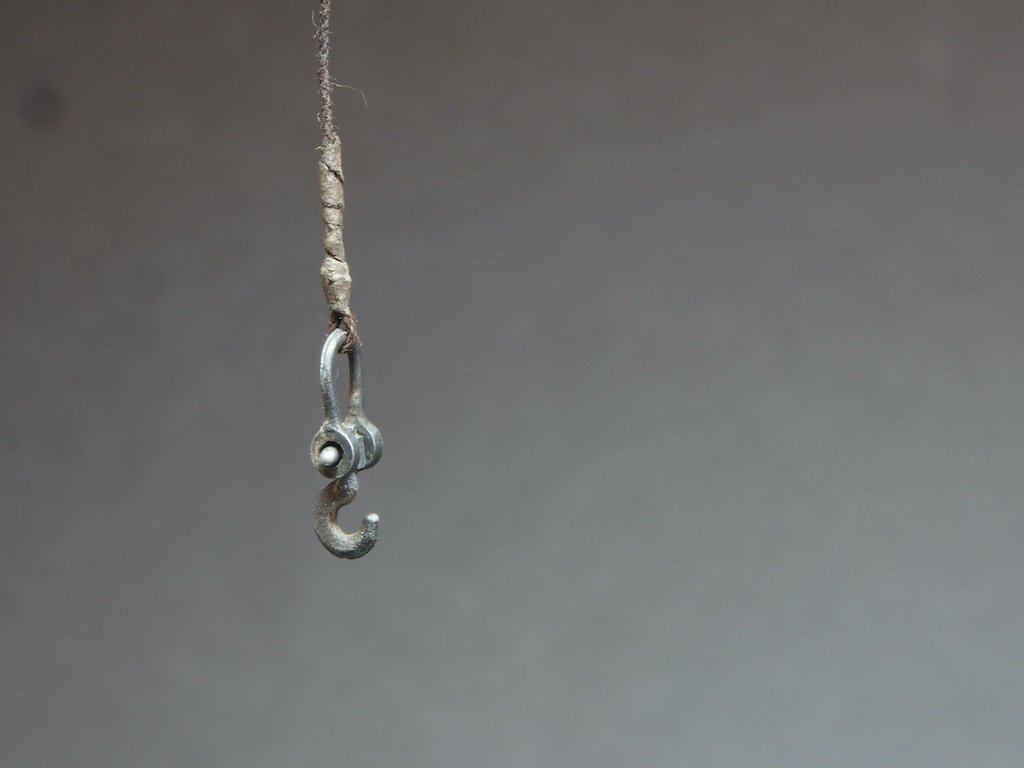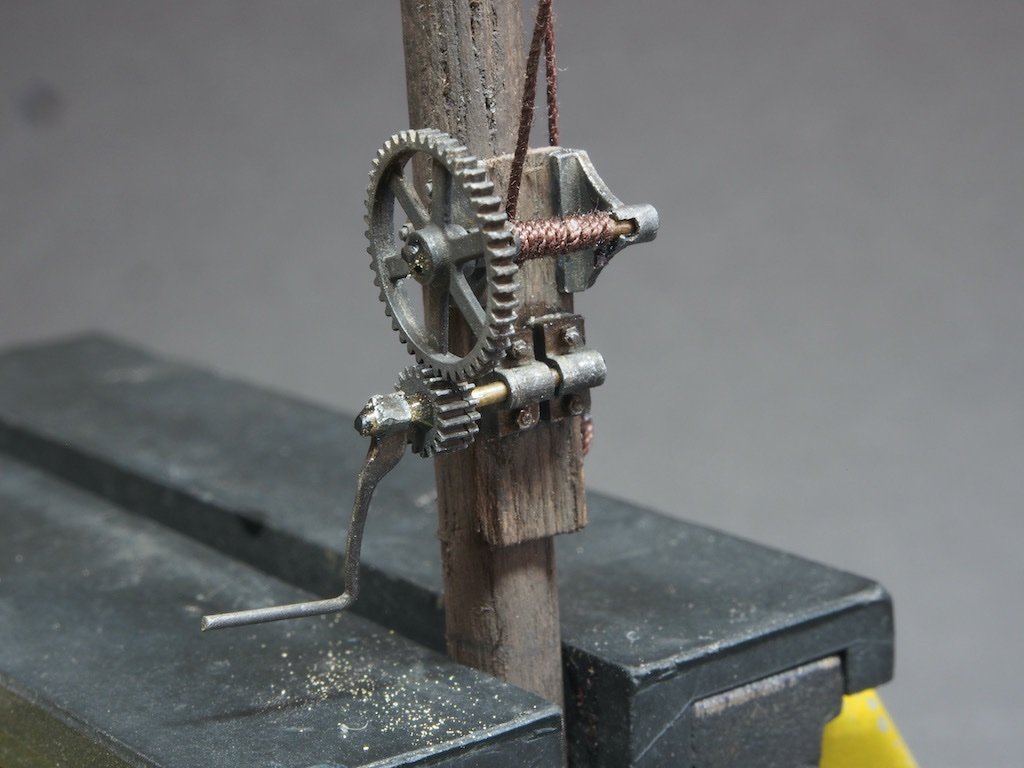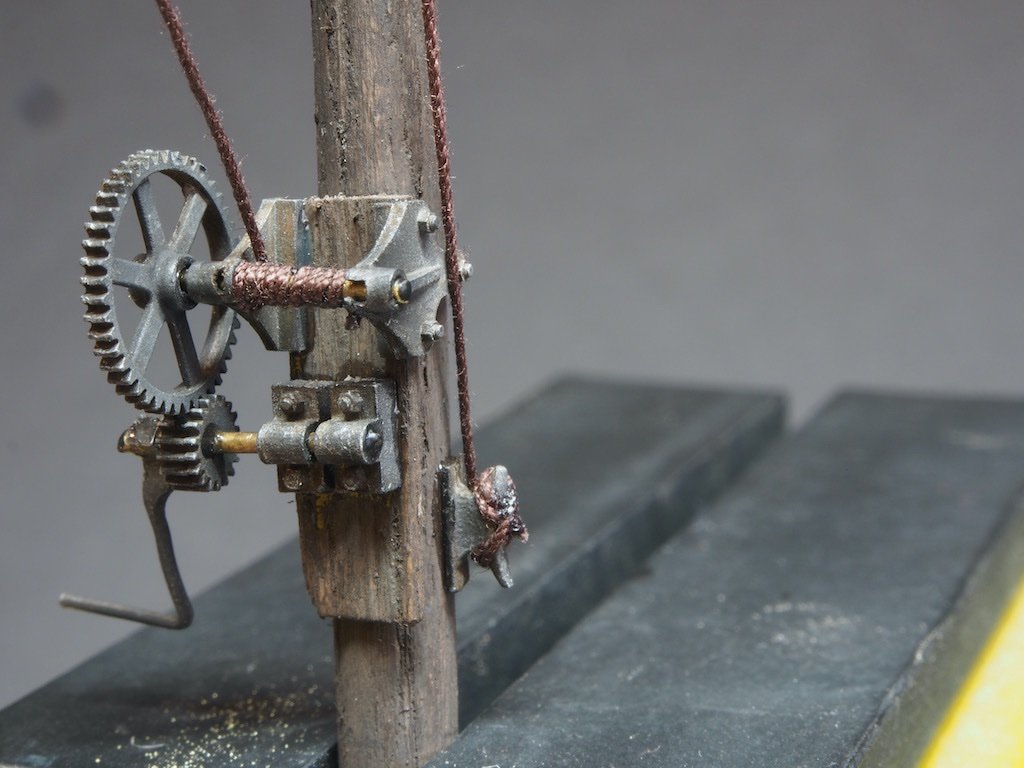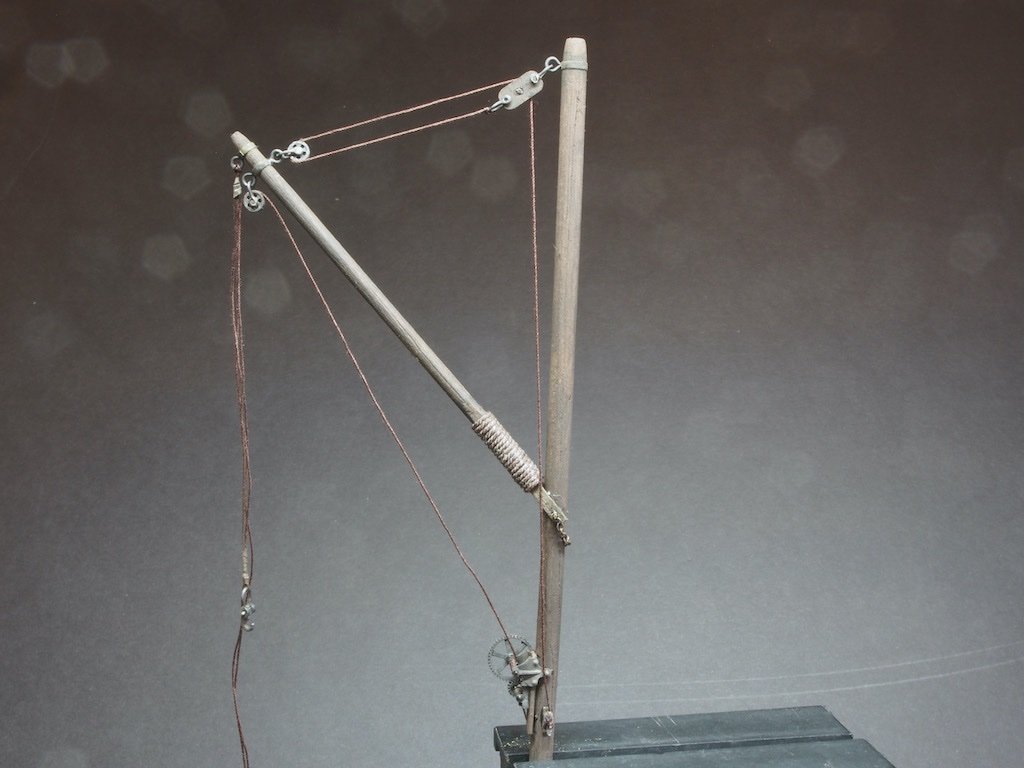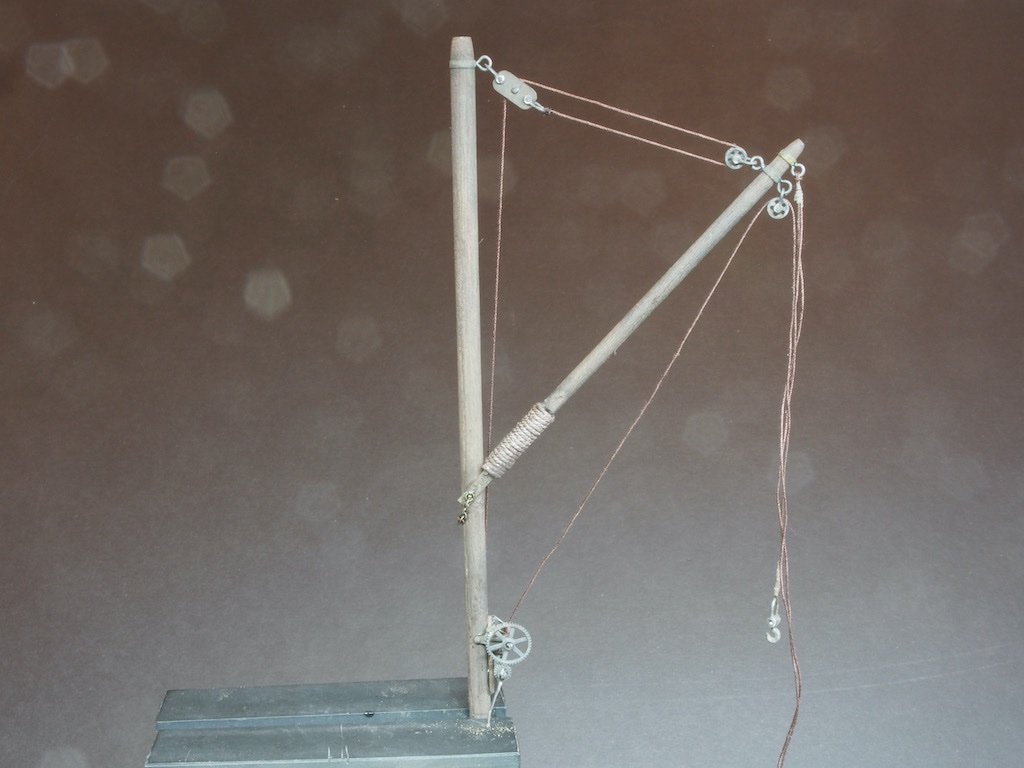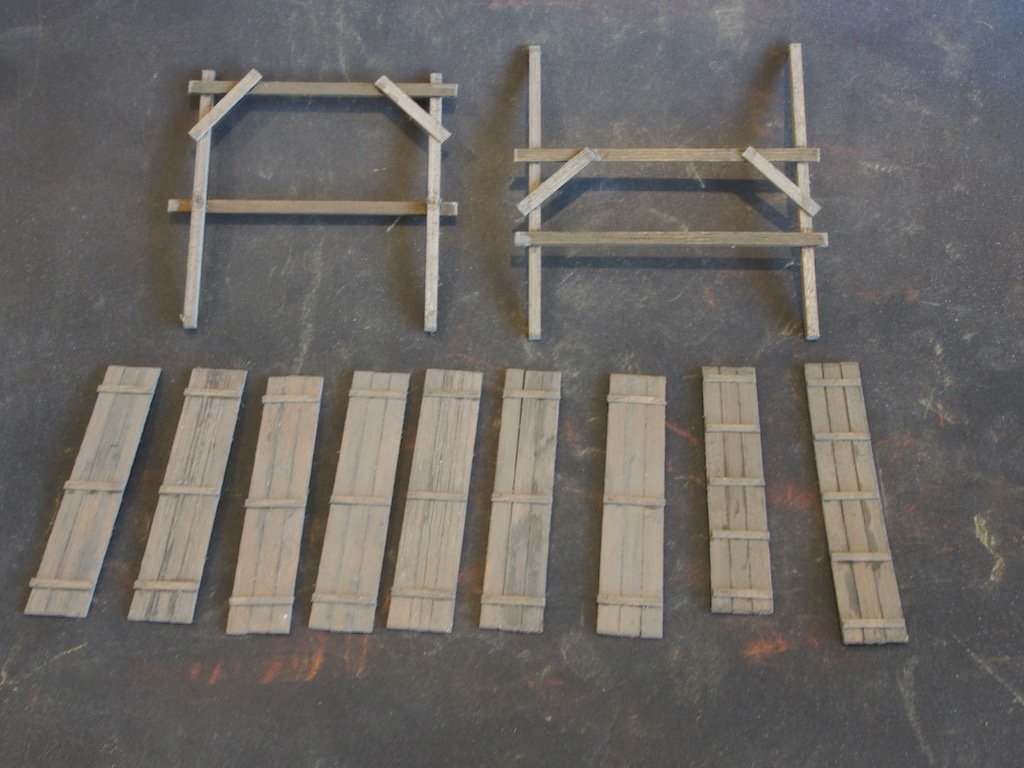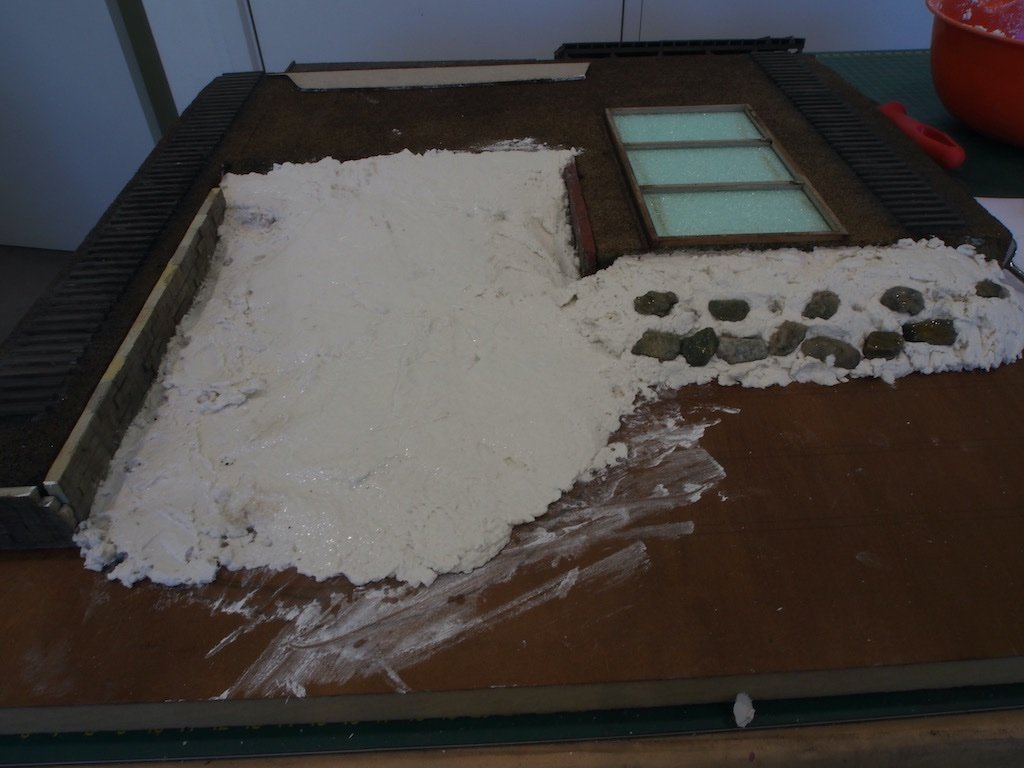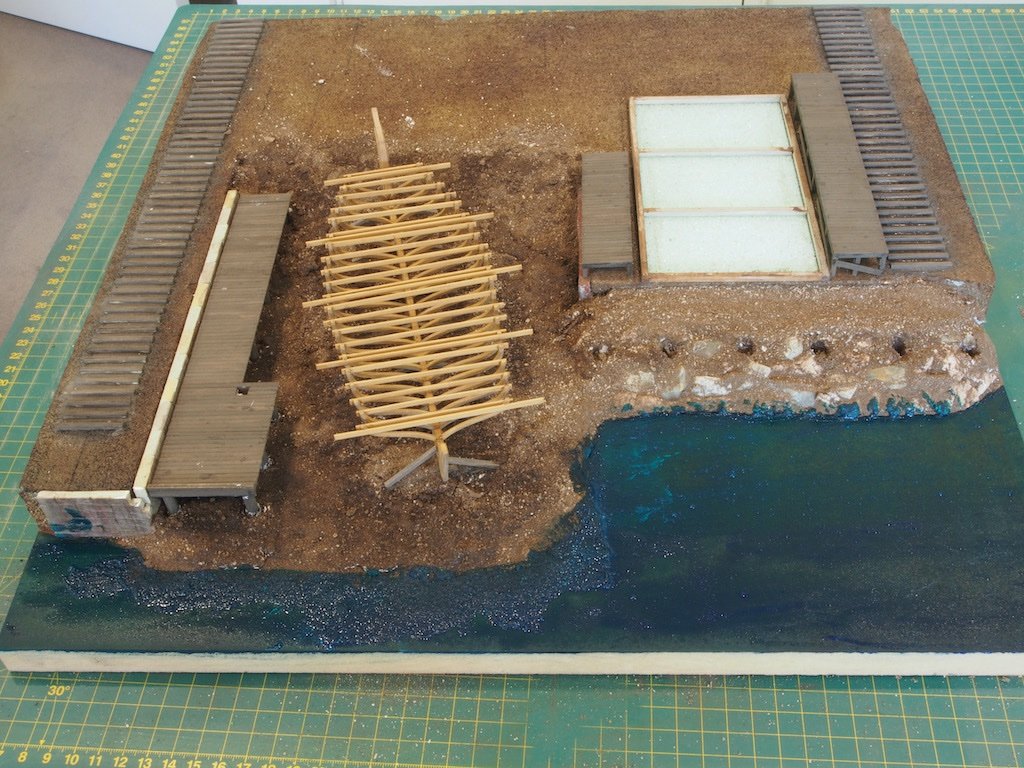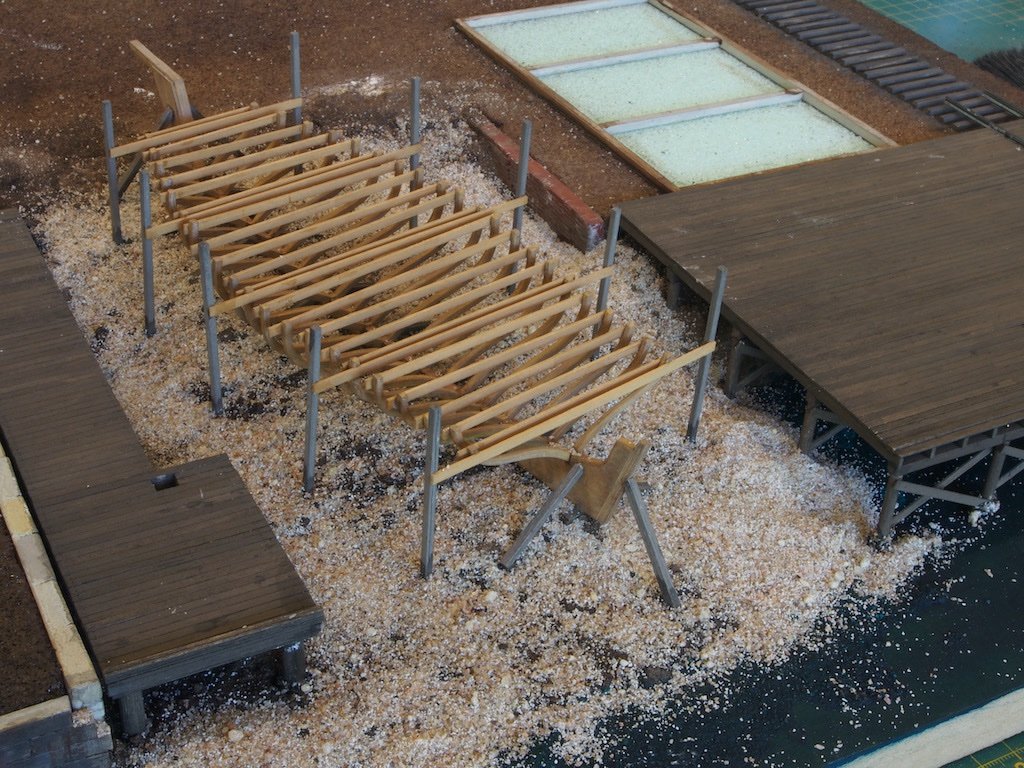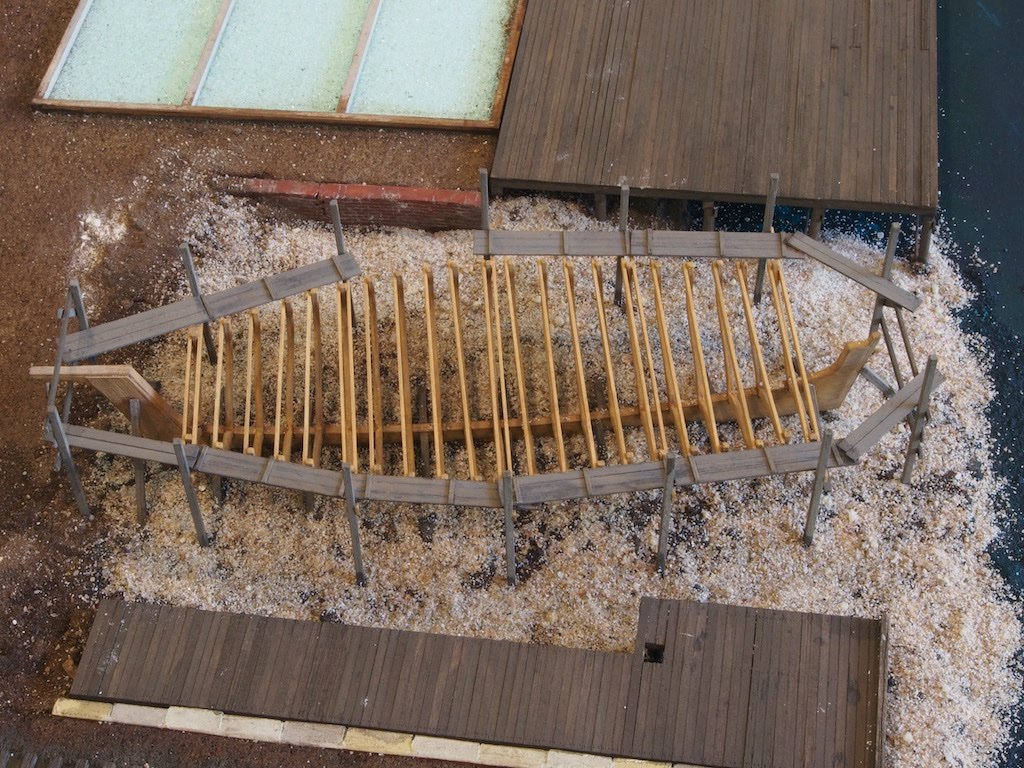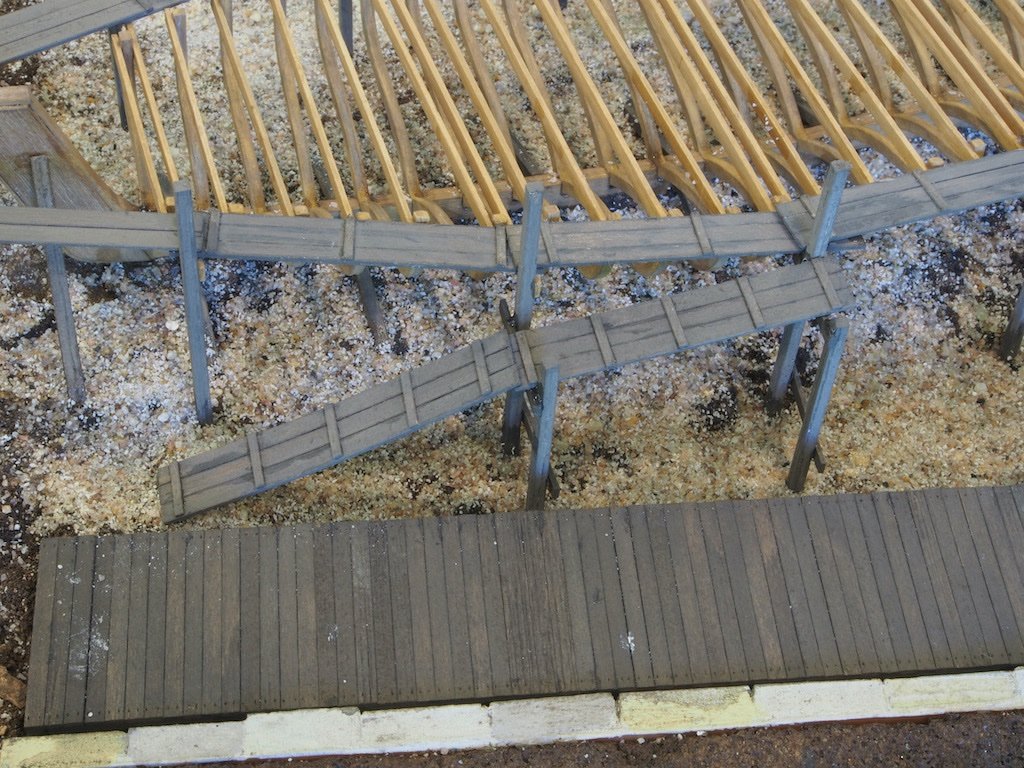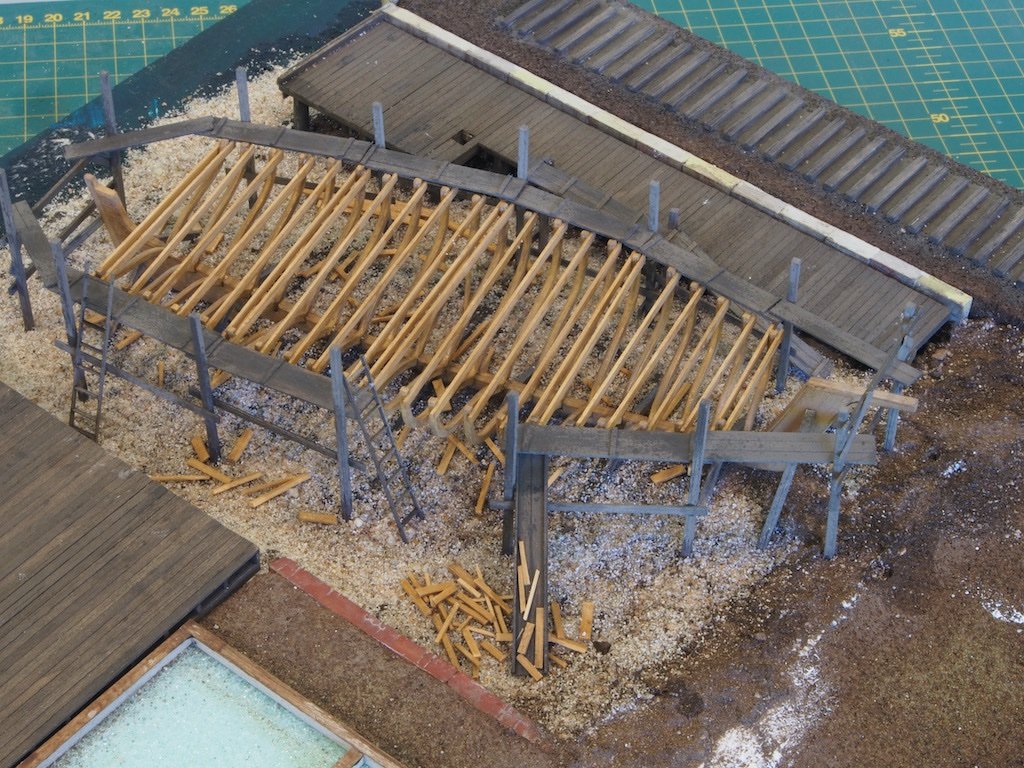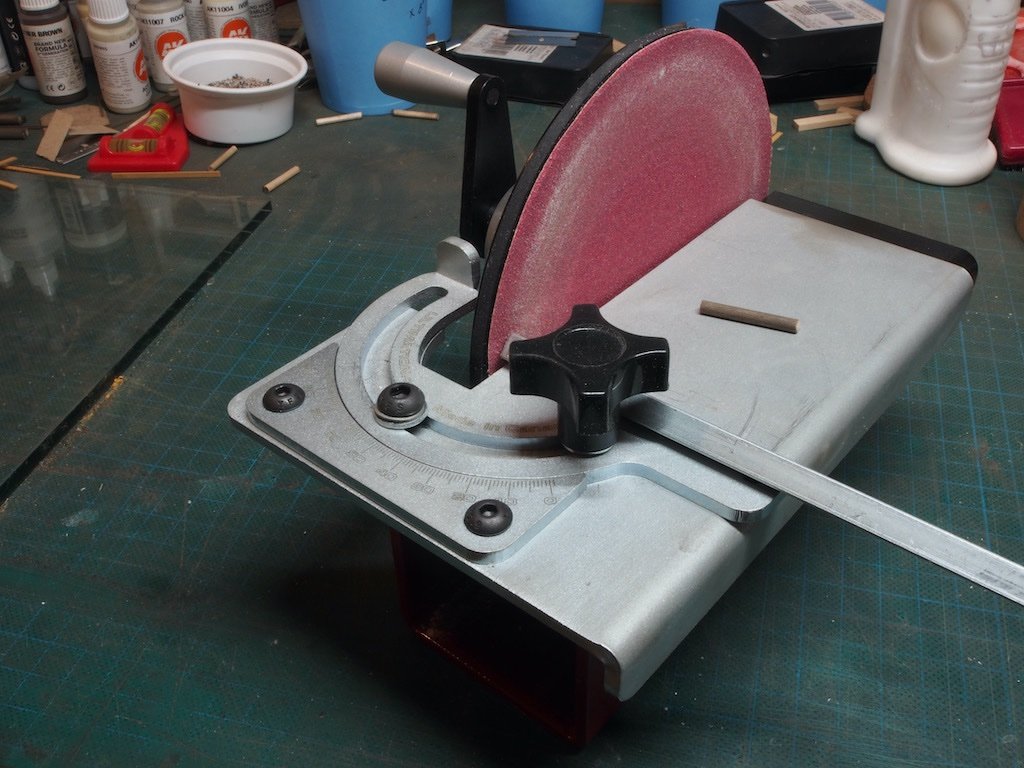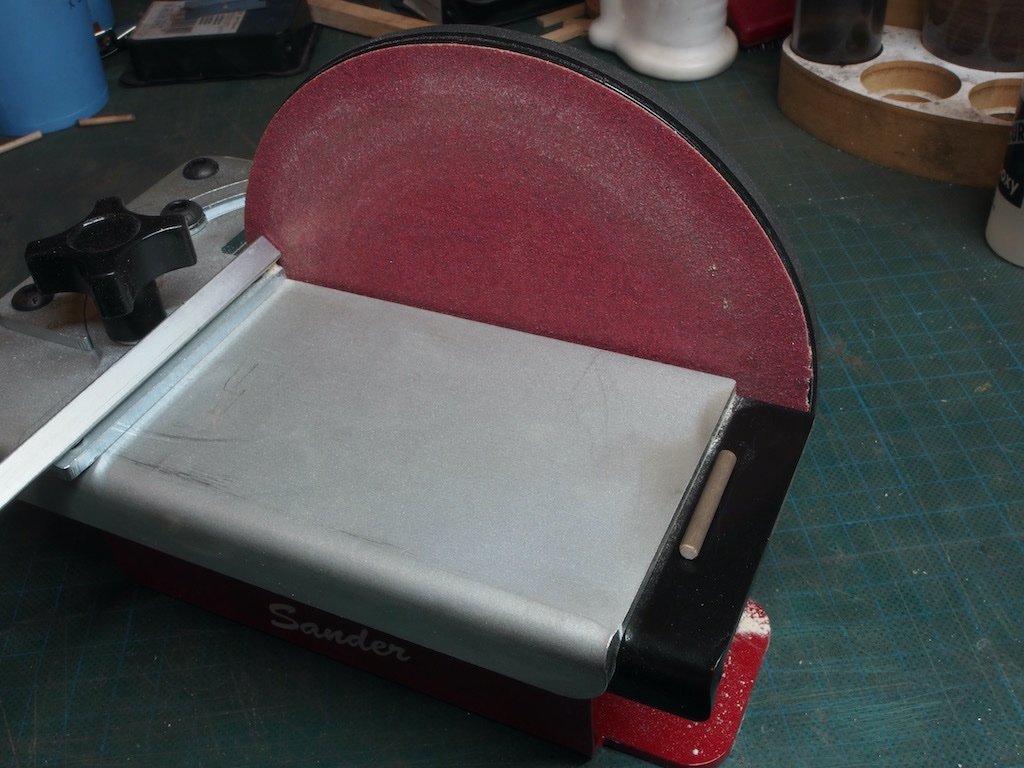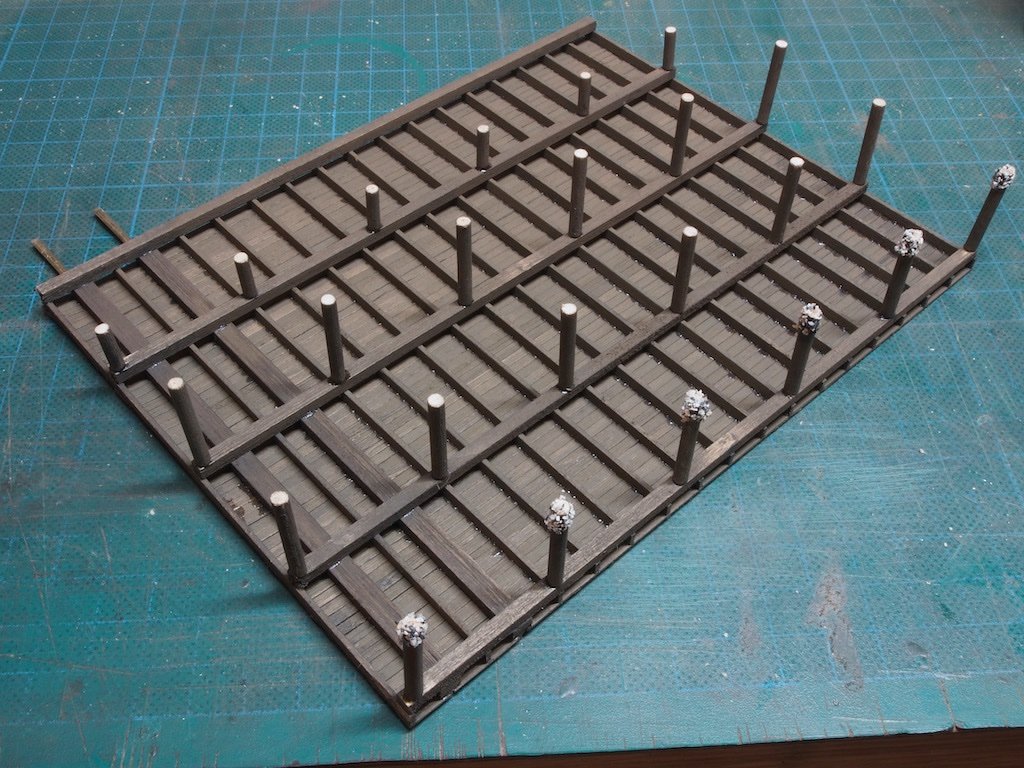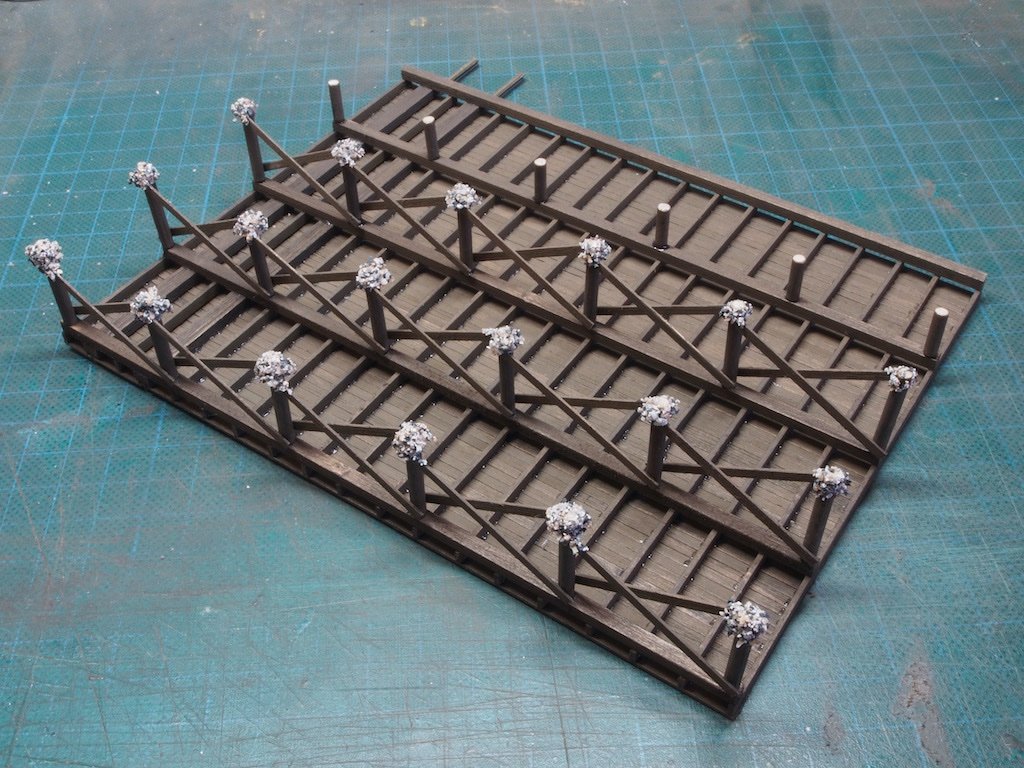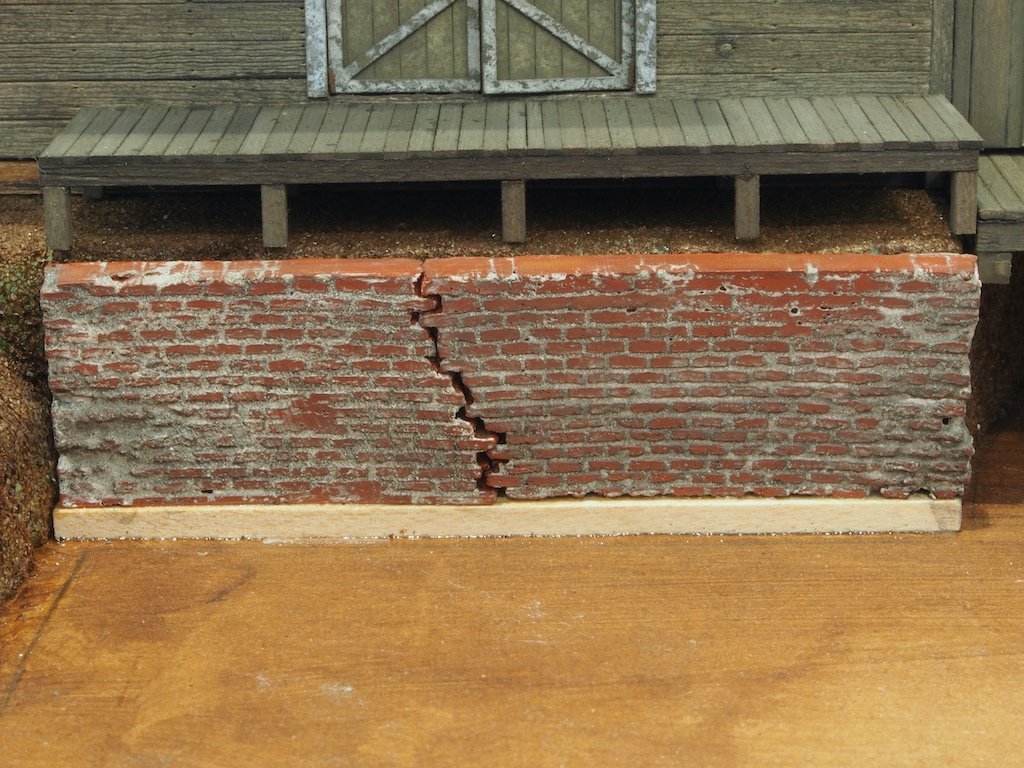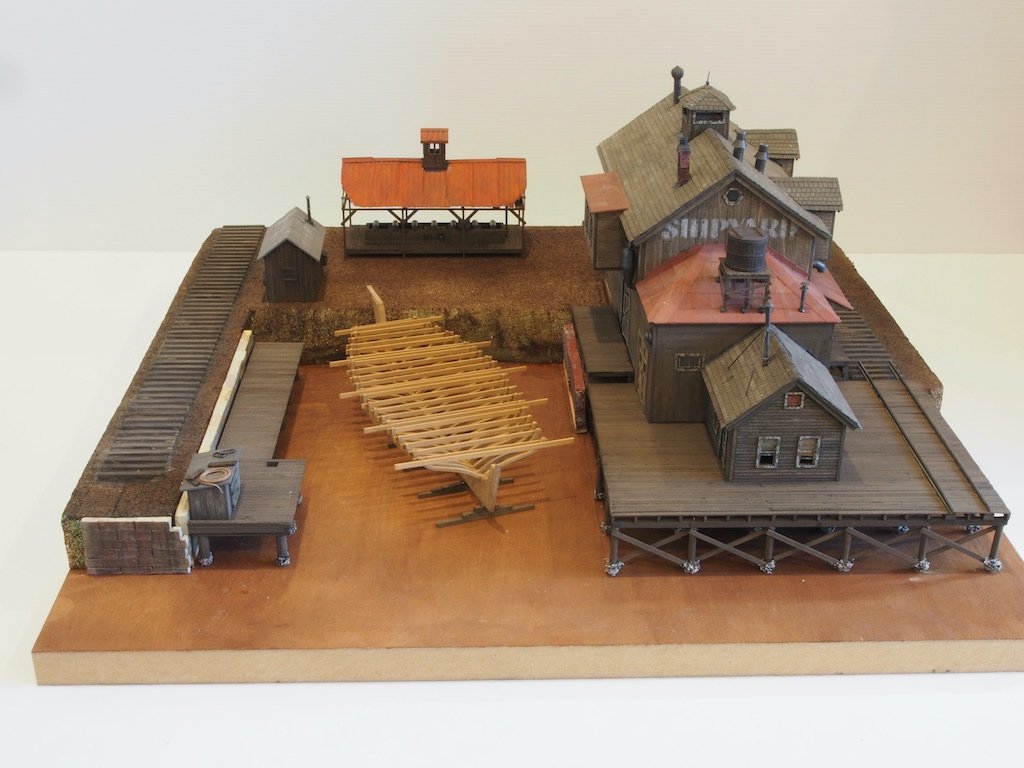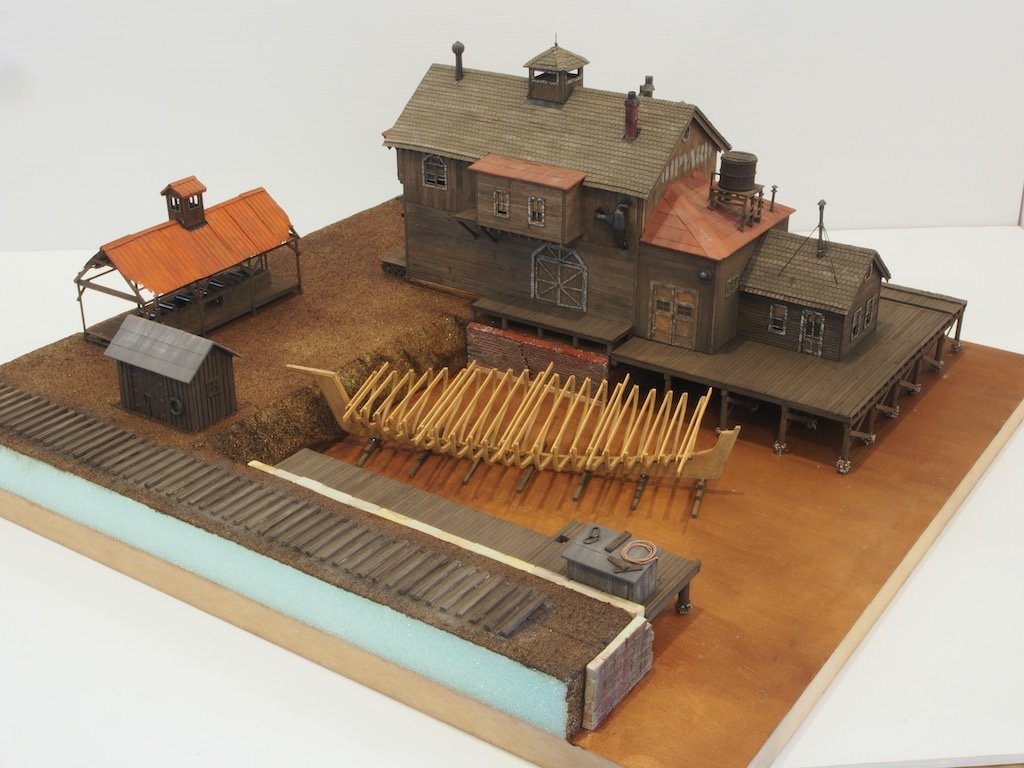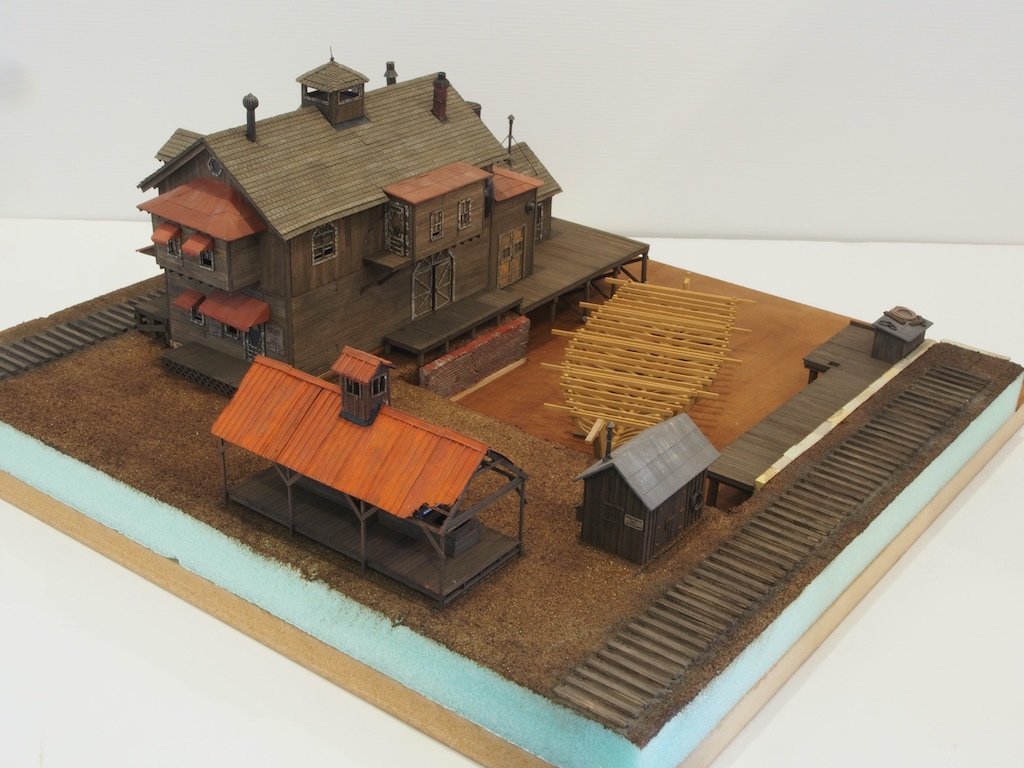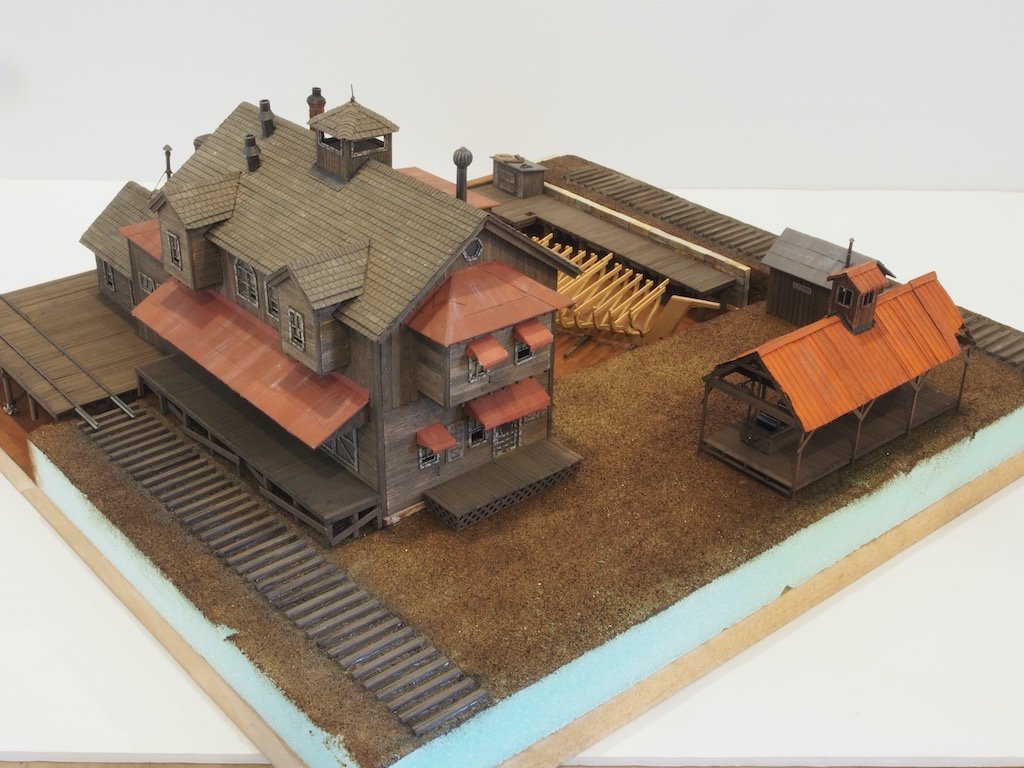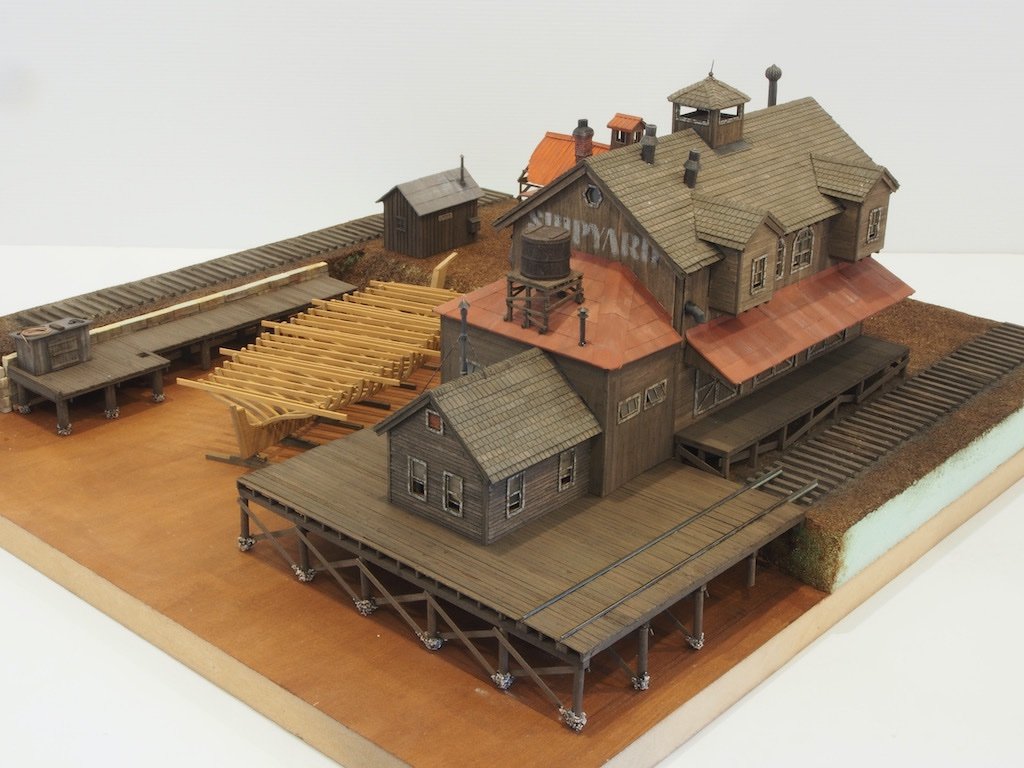-
Posts
4,872 -
Joined
-
Last visited
Content Type
Profiles
Forums
Gallery
Events
Everything posted by gjdale
-
Just a thought Keith, but rather than printing across many small sheets and having to stick them together (with inherent risks to accuracy), why not take your PDF to a local plans printing shop and ask them to print on a large format paper? I don’t think the cost would be prohibitive, particularly taking the benefit into consideration.
-
A minor update... The Wooden Fence As the kit instructions remind us, fences create a barrier that allows us to define a scene. This is a simple board on board construction using the provided template to define the overall dimensions and placement of key components – the posts and rails. The posts are made from 3/64” square stripwood, and the rails from 0.020” x 1/16” strips. Individual boards of 0.02” x 3/32” are then applied after applying plenty of texture, splits and cracks. I forgot to take any in-progress photos, but here are a couple of completed shots. Overall view. And a close-up of the mid-section. The fence is now set aside for later placement on the diorama. The Bumper Pilings The bumper pilings are made from dowels. Unfortunately, there did not seem to be enough dowel of the right diameter (3/16”) provided in the kit to complete this task, so I supplemented the kit stock with some from my own stash. The latter were slightly larger in diameter and of a much harder wood. The harder wood made imparting grain much harder, and for this I used the edge of a saw blade for an exacto knife. Tyres are provided in the form of white metal castings which are blackened, buffed, painted and chalked before being attached. I did not like the look of the provided cotton string, and there was not enough for the task anyway, so again I substituted from my own stash for this. Again, I did not take any in-progress shots, so here are a few of the completed pilings. I tried to follow as closely as possible the distribution/layout shown in the example in the instruction manual, including deliberately leaning some of them. The main dock pilings. And the Barge Derrick Dock. The Steam Box The steam box was used for softening the planking, making it easier to bend to attach to the hull. Steam from the boiler was pumped into the steam box and a little while later, it was ready to go. This provides an excellent opportunity for creating a scene that tells a story within a story. The actual construction of the steam box is very straight forward with a solid core of ¼” square stock being clad in some .020” x 3/32” stripwood and 0.020” x 1/16” stripwood. Wrap braces are made from more of the 0.020” x 1/16” stripwood and applied. Finally, the legs and braces are made up from 3/64” square strips for the legs and 0.020” x 3/32” strips for the braces. Thin paper strips are used to create the hinges on the doors and a small white metal cast hose ring / inlet is blackened and buffed before being epoxied in place. Again, no in-progress shots, but here is the completed Steam Box – 3 ½” in overall length. Next up will be the boiler to accompany the Steam Box.
-
Thanks Glen and also once again for of the "likes". The Barge Derrick At first glance through the instructions, the Barge Derrick would appear to be a fairly simple construction. However, it proved to be a quite challenging element of the overall kit. The barge derrick is made up of a number of wooden parts and quite a few cast white metal parts – some of the latter being both tiny and rather fragile. First up, we gather the pre-cut wooden components – the mast, jib, the laser cut wooden block components, and a couple of wood strips – and grain and stain them after imparting a slight taper to the outer ends of both mast and jib. Next, we search through the dozens of tiny white metal castings to identify and extract the ones we need for this assembly. These are then cleaned and chemically blackened. These include the bearings (x2), pillow blocks (x2), gear wheel, pinion, cleat, pulley wheels (x3), crank, hook, clevises (x5) (I would call these shackles), eyelets (x4), length of chain, and 1/32” diam brass rod. In the picture below, I have included the tips of my tweezers on the right-hand side as an indicator of scale. The very first issue I had was losing the tiny pinion gear while cleaning the parts – it pinged off the end of the tweezers and fell straight through the hole in the space-time continuum, never to be seen again. This was unfortunate, as this particular piece was a unique shape. Luckily, I was able to substitute a very similar piece from the additional castings and only the kit designer will ever know the difference! Next, we are instructed to lay a piece of masking tape on the bench and colour it with a little Polly Earth (I used AK 11008, Grimy Grey) and some brown chalk powder. A thin strip about 1/16” x 1 1 /2” is then cut off – we need a few of these, so they were all made at once. I diverted from the sequence in the instructions a little from here on, just to keep the workflow going. The next step was to wrap the tape around the top end of the mast and then drill a hole for an eyelet to be epoxied in place. Two more strips and three eyelets are also added to the outboard end of the jib. One of the pulley wheels is epoxied to the inside of one half of the laser cut block and once dry, the other half of the block is epoxied in place and two very short brass pins are cut from the length of rod and inserted through the holes in the end of the block. Two wood strips, each about 1” long are then attached to the inboard end of the jib, with about half their length overhanging the jib end. Once dry, we are instructed to wrap these strips with the provided waxed thread for about ¾ of their length, leaving about ¼” of the strips exposed. These are what is used to attach the jib to the mast. This is where I ran into two problems. Firstly, the length of thread provided in the kit is insufficient to wrap the length directed. This was no big deal – I have a sizeable stash of high-quality (Syren) rigging thread for my ship modelling, so it was easy to find some of the same thickness, run it through some wax and proceed. The slightly bigger issue is that if the wood strips are wrapped too far, they will not expand far enough to fit around the diameter of the mast (which is thicker than the jib) – in fact, it snapped the wood strips on my first attempt. Again not a huge deal – I simply replaced the two wood strips and this time wrapped them in thread only as far as the end of the jib. I used a little CA to secure the wrapped thread at this point and left a long ‘tail’ hanging until after the jib was secured to the mast. The provided template was used to position the jib and set the correct angle. It was epoxied in place to the mast and left overnight to fully cure before completing the wrapping with the thread. Once cured, two holes were drilled through the wooden strips and into the mast and short brass pins were epoxied in place to accept the preventer chain. Here I ran into another issue. The links in the provided chain are too small to fit over the brass pins. Although the instructions advise us to use the ends of our tweezers to force the link open sufficiently, I was unable to achieve this. No drama – back into the ship modelling stash and after a quick rummage, came up with a length of chain with ever so slightly larger links. Problem solved. The next issue I encountered around this time was the softness of the white metal castings – specifically the clevises/shackles. The first thing needed to be done with these is to use a drill bit or reamer to open the holes sufficiently to take the axle pins of the pulley wheels, or the brass rod (both are 1/32” in diameter). I managed to destroy two of the five in the process. I was able to find one more of the same size among the myriad of castings, and also found two that were slightly larger, so used one of these as a replacement also. Two clevises/shackles are attached to either end of the large wooden block. The photo makes the block look grey but it is in fact brown, as is the mast itself - i just had to adjust some settings while editing the photos to make the parts more visible. Two more are used to attach the pulley wheels to the eyelets previously installed. The larger replacement clevis/shackle was used to attach the hook. The rigging thread also gets some tape wrapped around it just above the hook. The bearings, gear, pillow blocks, pinion and crank are then epoxied in place at the base of the mast. This was quite a slow process as it was necessary to wait for the epoxy to dry on one component before adding the next. However, they were all placed without incident. The rigging line from the hook was also wound around the shaft of the gear wheel. And a view from the other side showing where the rigging line from the jib end is secured to the cleat at the base of the mast. I will add a small coil of extra line to the cleat once the derrick is finally placed on the diorama. And finally, here are a couple of overall shots of the completed derrick. Note the extra line hanging from the end of the jib. This will be secured to items on the dock once the derrick is finally placed. A wooden fence and some bumper pilings are next on the agenda…
-
Just stumbled across your build log Tim. Looks like you’re off to a great start. I’ll pull up a chair and follow along from here.
- 72 replies
-
- Seguin
- BlueJacket Shipcrafters
-
(and 2 more)
Tagged with:
-
Having had some enforced time off due to the "attack of the killer carrots", it's time to resume normal programming. The Scenery Base Having read through the instructions several times, including reading ahead to the next section, I decided to do things a little out of sequence and make up some of the scaffolding that would be needed shortly. I wanted to have this on hand and ready to go when it was needed, rather than making it up while watching the clock on setting times for the scenery base. The scaffolding items are relatively simple, and all are made according to provided templates in the plans. These consist of the bow and stern scaffolding assemblies, the scaffolding walkways and two ramp pieces. Here they are ready to go and put aside until needed. Not shown here, the keel bracing was also added at this time rather than waiting until the ship was placed in the scenery. These are simply bracing pieces that run from the outer ends of the keel supports to the keel itself. Sorry – no photo of this bit. As it turned out, I was very glad that I installed these at this point. The next step was to mix up some Sculptamold to contour the shoreline and create the pit for the ship. I was very apprehensive about this as I had never done anything like this before and it is also a “point of no return”. It actually took me three attempts at mixing the Sculptamold before I had a consistency that I was happy with. A cardboard template of the ships keel is provided to assist in shaping the pit area. A little AK 11008 paint (in place of the called for Polly Earth) is added to the water before mixing with the Sculptamold. I also added a few small stones to represent rocks in the area under the dock. In the picture above you can see the indentation made for the rear pylons of the dock. The instructions say to spread a base layer of dirt over the Sculptamold before pressing the ship down to sink the keel supports just a bit into the Sculptamold. I found that the surface of the Sculptamold had already hardened to a point that made this impossible, so I mixed up a fresh batch, spread it over the area where the ship was to go, and then placed the ship into it. I subsequently added some more dirt over the top. The barge derrick dock was also placed at this time. I was able to create some holes in the Sculptamold by pushing a 3/16” diameter brass rod into the mix. This allowed me to place the supporting pylons at the right depth for the height of the dock surface. A little epoxy was added to the bottoms of the pylons to secure them in place. Once a layer of dirt was added, it was then lightly wet down with “Wet Water” (water with a few drops of dish detergent) sprayed from a plant sprayer bottle. A mixture of 50/50 white glue and water, with a couple of drops of dish detergent, is then applied over the entire surface using an eyedropper/syringe. At this point, I also decided to change the colour of the bottom of the water area and added that by applying some artists acrylics – a mix of Turquoise, Phthalo Green, and Aquamarine – trying to have the lighter green colour towards the shore, and a deeper blue further out to represent the deeper water. In the above picture, you can see on the left-hand side where an errant brush stroke hit the sea wall. I was able to remove this later with the gentle application of an alcohol/ink wash. Completing the Ship Once the base had dried, I decided that I didn’t like the plain dark brown of the floor of the pit, so I mixed up some sand and two different light-coloured HO scale ballasts, and sprinkled that over the dirt, again applying a white glue/water mix to seal it in place. The main scaffolding supports were then added. Once again, I found that by using an awl to make an initial indentation, I was able to push the supports down into the Sculptamold. These were each glued to the scaffolding rib braces previously installed on the ship. Additional keel supports were also added at both bow and stern. The scaffolding walkways could then be glued in place. The two-part ramp was then added to the port side. As suggested by the instructions, a slight bow was imparted into the lower section, adding to the appearance of age. Finally, some bracing pieces were added between neighbouring scaffold brace supports. Two ladders were made up and placed, and a scrap wood chute was made up and placed towards the bow end. Then some small pieces of scrap wood were added to the chute, and more scraps were scattered around the pit. All of these scraps were given the white glue/water mix treatment to secure them in place. It's a bit hard to see in the photographs, but the white glue/water mix has left a bit of a sheen on the scrap wood pieces. I may need to go back and carefully apply some dull cote to knock that back. In the meantime, that completes the work on the ship and the next step will be construction of the barge derrick.
-
Congratulations Glen, a real masterpiece in miniature. As others have already said, whimsical, creative, amusing, and highly skilled execution. You’ve set a high bar my friend - I’m looking forward to your next creation.
-
A quick update to say there won’t be an update for a couple of weeks at least. A mishap with a kitchen knife last night resulted in a trip to emergency and a thumb now wrapped in bandages for a week or so. Not too serious - sliced a good part of the pad of my left thumb away - but no modelling (or anything else that requires thumbs for that matter) for at least a week. I’ll be back once work is underway again.
-
The Dock Pilings Completion of the Main Dock is fairly straight forward. Having previously determined the correct length of pilings required, it was simply a matter of graining and staining the 1/8” diameter dowels and cutting them to length. The position of the pilings is indicated on the provided template and the instructions suggest adding three rows of full height pilings and one row of half height pilings – the latter being to accommodate the addition of scenery base. I will digress for one moment to show off my newest toy. It is a hand operated disc sander (by Ultimation) and is brilliant for fine tuning and especially for squaring ends. Although I already own a very good, powered disc sander (Byrnes), the hand operated version offers excellent fine control. I stumbled across this reading through the Sierra West forum. A neat feature is that there is a ledge at the end of the table that provides a perfect 90-degrees – very useful for squaring up ends. Once all the pilings had been cut and the ends de-fuzzed and squared off, I drilled a 0.6mm hole in the end of each and inserted a piece of 0.5mm brass rod to act as a locating pin and to assist holding the pilings in place while the glue dried. The pilings were all attached using 5-min epoxy. The instructions also direct us to add barnacles to the first row of pilings at this stage – a task that would be better left until after the addition of the bracing. Bracing strips are then cut to length (using the template) from 0.020” x 3/32” strip that has been grained and stained. The instructions then again direct us to add barnacles to the first row. This is the right time to do this, as having already done it prior to adding the bracing, I then had to scrape most of it off to allow the bracing to be placed properly. I also decided to add the barnacles to all of the first three rows. That completes the main dock. I then decided to re-visit my brick wall. One of the Sierra West gurus had kindly suggested that it might be a good idea to tone down the brightness of the mortar by applying a light wash of alcohol and ink. I did this and am quite pleased with the result. The next step will be adding the scenery base before “planting” the ship and adding the scaffolding around the ship. I must confess to being somewhat apprehensive about this stage, only because I have never done anything like this before. What could possibly go wrong? In the meantime, here are a few “spin” shots of all the completed work to date. The diorama has been cleverly designed to present an interesting view from all sides. I’ll be back once the scenery base is underway…
-
You’re doing a good job so far Etubino. Despite its many shortcomings, this kit does build up into a very nice model if you are patient and persevere. Be careful with the instructions. If memory serves me correctly, they will “paint you into a corner” regarding placement of some of the guns by advising you to insert completed guns/carrriages through the gun ports to the quarterdeck after the Poop deck has been fitted above. The guns/carriages won’t actually fit through the gun ports, so you will need an alternative solution.
About us
Modelshipworld - Advancing Ship Modeling through Research
SSL Secured
Your security is important for us so this Website is SSL-Secured
NRG Mailing Address
Nautical Research Guild
237 South Lincoln Street
Westmont IL, 60559-1917
Model Ship World ® and the MSW logo are Registered Trademarks, and belong to the Nautical Research Guild (United States Patent and Trademark Office: No. 6,929,264 & No. 6,929,274, registered Dec. 20, 2022)
Helpful Links
About the NRG
If you enjoy building ship models that are historically accurate as well as beautiful, then The Nautical Research Guild (NRG) is just right for you.
The Guild is a non-profit educational organization whose mission is to “Advance Ship Modeling Through Research”. We provide support to our members in their efforts to raise the quality of their model ships.
The Nautical Research Guild has published our world-renowned quarterly magazine, The Nautical Research Journal, since 1955. The pages of the Journal are full of articles by accomplished ship modelers who show you how they create those exquisite details on their models, and by maritime historians who show you the correct details to build. The Journal is available in both print and digital editions. Go to the NRG web site (www.thenrg.org) to download a complimentary digital copy of the Journal. The NRG also publishes plan sets, books and compilations of back issues of the Journal and the former Ships in Scale and Model Ship Builder magazines.


